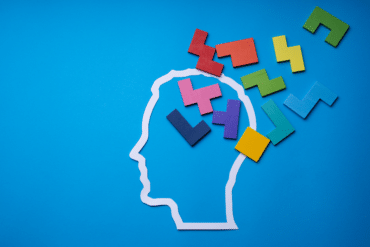People with sleep issues don’t always want to turn to medication for help. Soothing images in visualization meditation and cognitive control could be the solution.
While drugs can help you to overcome sleeplessness quickly, they’re rarely a long-term solution to the problems insomniacs have.
Over time, even the most effective medications can begin to lose their impact. Then you have to deal with the stress of getting off it. The issues with medication are why many doctors prefer to use therapeutic treatment options instead, ranging from CBT-I, to psychotherapy for sleep.
Although guided imagery has been advocated as a stand-alone intervention it is most often used in conjunction with other treatment interventions, such as CBT-I.
Cognitive control is just one aspect of the CBT-I strategy for insomnia treatment. With cognitive control, you learn how to replace tormenting thoughts and behaviours that maintain and worsen your sleeping habits.
Today, we’re going to take a closer look at cognitive control and cognitive flexibility in CBT. Additionally, how adding guided imagery meditation can assist you in getting a better night’s sleep.

What is cognitive control for sleep?
Cognitive control is a component of cognitive behavioural therapy. A strategy that helps train people to address thought patterns that are maintaining sleep problems.
As an alternative to sleeping medication, cognitive behavioural therapy helps you get to the bottom of your sleep problems. Giving you the benefit of long-term results. You can learn how to transform your body clock, improve your thought patterns, and more.
Cognitive behavioural therapy works. Countless studies show that the right mixture of treatments can help with everything from stress and anxiety to poor sleep scheduling.
Over time, if you’re willing to commit to regular sessions with a trained professional, you can overcome your issues with trouble falling asleep at night, early morning waking, and general anxiety around sleep.
Cognitive control of emotions is one of the fundamental aspects of CBT-I, cognitive behavioural therapy for insomnia. It works alongside guided imagery and psychotherapy to help people identify the beliefs and attitudes that are hindering their ability to sleep properly.
Gradually, you can work with a therapist to process your thoughts and feelings about sleep. Because of a deep focus on emotion, cognitive control is often a strategy that’s recommended for people with sleep anxiety issues.
With cognitive control of thoughts and emotions, therapists teach patients to promote positive attitudes and belief structures. Finding and eliminating negative automatic thoughts about sleep.
Before we continue check out these great products on Amazon.
Identifying core beliefs questionnaire and negative self talk worksheet
Cognitive control include scheduling time into your routine when you can process your worries. Maybe you come up with to solutions to your negative thoughts about sleep.
Your therapist will ask you to identify your core beliefs about sleep. What negative inner dialogue do you have around sleep? CBT-I offers certain worksheets where you can identify and write down your thoughts and emotions about sleep.
When you have realized the nature of your negative self talk, you can find the specific thoughts leading to tormenting emotions keeping you from your slumber.
At the end of this time, you may feel more free to relax. If needed, your therapist will help you interpret and change your thoughts during your next session.
It might take some time to get used to this form of therapy where changed thoughts brings changed emotions, but it’s with the work.
When therapists choose cognitive control as a method for improving insomnia, they often also use guided imagery.
Guided imagery and meditation allows you to imagine that you’re in a story, paying attention to the way that things look, feel and sound.

What is guided imagery for sleep?
The aim of guided imagery is to make the experience feel as real as possible. With these visual meditations, you can move beyond negative feelings and relax more easily.
Have you ever “counted sheep” to help yourself fall asleep?
You’ll know it can be valuable in pivoting your mind away from a set of negative thoughts, when you’re trying to rest.
Usually, when we count sheep, we’re doing it because we don’t want to focus on something we’re worried about — like an inability to sleep.
Guided imagery for sleep and visualization mediations might seem like complicated things. They’re actually just small exercises into relaxation techniques.
It’s a gentle and effective method that helps a participant to evoke and generate mental images that simulate or re-create the sensory perception.
With a therapist, you’ll engage in 30 to 90-minute sessions where your thoughts can be purposefully redirected through imagination and proper visualization.
While the goal is often to help with falling asleep, guided imagery can also be useful for managing stress, pain, anxiety, and depression too.
The good thing about guided imagery is that it’s a highly focused practice that involves all of your senses. You need to be able to focus on hearing, tasting, touching, smelling and feeling things in your meditation sessions.
That means that it really helps you to get to the bottom of your thoughts and feelings. Research shows that the practice can reduce feelings of fear and anxiety drastically, while lessening feelings of psychological distress.
The bad news is that figuring out how to master true cognitive flexibility usually takes time and concentration. Just like any home mindfulness routine, it’s going to take time to learn how to make the most of your ability to imagine.
Fortunately, you can add cognitive control and guided imagery for sleep into your routine both with and without the help of a therapist. That’s particularly true now that there are countless meditation apps online to help you.

How to use guided imagery meditation
Using guided imagery for sleep can help both children and adults alike to find a comforting and relaxing way to drift off into their evening slumber.
As a form of directed visualization, this therapy is based on the idea that the mind and body is connected. If you can tap into your own imagination, you can overcome anxieties and fears, and have a more soothing sleep.
The first step is making sure that you’re in a comfortable and relaxing atmosphere to begin with. Just like traditional meditation, it’s okay to let your mind wander away from the narrative provided to you with your guided imagery.
Most people experiment with incorporating things like silence or music to help them on their relaxation journeys.
Many people using cognitive control and guided imagery for sleep is easier when they start with re-constructing a happy memory.
- Think back to a time in your life when you felt calm and happy.
- Try to imagine the aroma that you smelled, the temperature, and how you felt.
- Think about the things that you heard, the tastes of the things you ate, or just the feeing of the textures around you.
For instance, maybe you’re thinking about a time when you visited the park with your family. Maybe you were sitting on a picnic blanket, but you could feel the grass under your legs still.
Perhaps there was a smell of flowers around you, and you could feel a soft breeze on your face. You can imagine biting into a slice of cake and tasting the rush of sugar and flavours on your tongue.
The more detailed you are with your relaxation images, the less room your brain will have to focus on other, more negative things that could make it harder for you to fall asleep.
Eventually, you might even find a few guided imagery for sleep scenarios that you use whenever you’re struggling with insomnia.
Not only does guided imagery meditation help you to control your emotions and how they affect your health, but it could help with things like nightmares too.
Although you can’t control what you dream about when you enter REM sleep, imagining pleasant things before you go to bed will help you to prep your mind to pull positive memories from your brain, rather than negative thoughts.
If you’re spending less time worrying about nightmares when you go to bed each night, then you’ll also find that you’re less likely to worry about your sleep. Your stress and feelings of sleep anxiety may diminish.
Over time, it may take a matter of minutes for you to find the guided imagery that you want to use for sleep and visualize yourself into the perfect slumber.

Do you need help with cognitive flexibility?
Cognitive flexibility in this setting is your ability to make your mind visualize the right images.
Although research suggests that improving your cognitive flexibility with CBT-I can assist with a lot of insomnia issues, it also takes a lot of practice.
You need to utilize all of your senses, from taste and vision, to smell, touch, and sound. Every sense is required to build a realistic image in your mind.
Cognitive control is a complicated thing. Just like any practice for mindfulness, the more you work on your cognitive control homework, the more natural the process will become. Your therapist will support you.
If you’re not used to this kind of visualization or cognitive processing, then you can’t force it. It’s going to take time to really feel the impact of cognitive control work on your sleeping strategies.
The good news is that when used correctly, guided imagery can really change your life, stimulating changes in heart rate, blood pressure, and even breathing patterns.
Clinical trials have proven that cognitive control and guided imagery for sleep helps to reduce stress, relieve pain and eliminate occurrences of insomnia.
Additionally, the Mayo Clinic notes that guided imagery meditation is frequently used for surgery patients. The people who participate in this practice require less pain medication on average than the people who didn’t.
While there’s no guarantee that guided imagery and cognitive control will work for you, it may be some of the CBT strategies worth discussing with your doctor or therapist.
It’s amazing what you can accomplish with full control over your mind.
Siestio. Sleep Matters.
General advice disclaimer
This article contains general tips and advice. However, no diet or exercise program should be started without consulting your physician or other industry professional first. For more information read our full disclaimer here.








